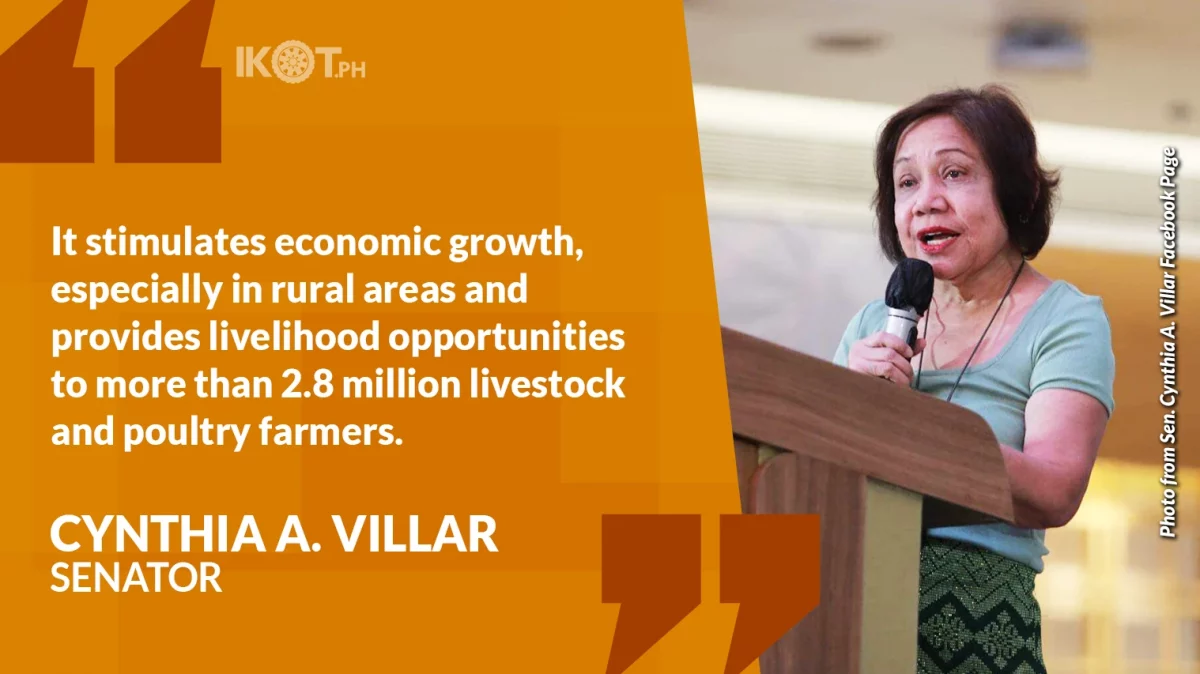Senator Cynthia Villar sponsored a bill “crucial” to unlock the immense potential of the country’s livestock, poultry, and dairy (LPD) industry, ensuring the sustainable growth and development of our agriculture sector.
Villar sponsored Senate Bill No. 2558 under Committee Report No. 193 or “An Act Strengthening Livestock, Poultry, and Dairy Industry Development and Competitiveness, Rationalizing the Organization and Functions of Relevant Government Agencies, and Creating a Competitive Enhancement Fund Therefor”.
In filing the bill, the chairperson of the Committee on Agriculture, Food, noted they endeavor to advance the development and competitiveness of the LPD industry since it accounts for more than a quarter of the agricultural sector’s output in 2023.
“It stimulates economic growth, especially in rural areas and provides livelihood opportunities to more than 2.8 million livestock and poultry farmers,” the veteran legislator explained.
The seasoned lawmaker also said pork, and chicken are integral components of the Filipino diet, helping ensure a balanced intake of nutrients.
“It is estimated that 52.0 percent of our protein consumption comes from pork and chicken, and this is projected to grow even higher to 58.0 percent in 2030.”
“It is estimated that 52.0 percent of our protein consumption comes from pork and chicken, and this is projected to grow even higher to 58.0 percent in 2030,” the lady senator said.
Due to this, high meat prices could lead to protein deficiency and contribute to malnutrition. It could even affect learning outcomes.
In fact, the findings of the Organization for Economic Cooperation and Development or OECD’s Programme for International Student Assessment (PISA), students from countries with higher pork and chicken prices tend to have lower test scores.
Despite its importance, she lamented the LPD industry faces several challenges that hinder it from realizing its full potential.
“We know too well of the effect of disease outbreaks such as the African Swine Fever, which has been afflicting our hog industry and decimating our pork supply since 2019. This has resulted in a significant increase in the prices of pork products,” Villar emphasized.
Moreover, when compared to other agricultural commodities, the LPD sector historically receives relatively lower development assistance from the government
“The Philippine Institute for Development Studies (PIDS) data shows that from 2009 to 2020, fiscal support for the LPD sector averaged only P1.18 billion per year, accounting for merely 1.6 percent of the total budget of the Department of Agriculture (DA) for the period,” she said.
According to Villar, the Philippines is likewise struggling with dairy production and is heavily dependent on imported milk.
One of the major reasons that have led us to this situation, she said, is the highly fragmented government support structure overseeing the LPD industry.
Meanwhile, the proposed measure provides for the creation of the Livestock, Poultry, and Dairy Competitiveness Enhancement Fund or the LPD Fund.
“Building on the model of the Rice Competitive Enhancement Fund or RCEF established under Republic Act No. 11203 or the Rice Tariffication Law, tariff collection from LPD imports will be earmarked to the LPD Fund.”
“Building on the model of the Rice Competitive Enhancement Fund or RCEF established under Republic Act No. 11203 or the Rice Tariffication Law, tariff collection from LPD imports will be earmarked to the LPD Fund. It shall consist of an annual appropriation of P7.8 billion for six (6) years,” Villar said.
She said this amount will be utilized by the relevant agencies, on top of their respective annual budgets. The beneficiaries of the fund are small-hold raisers, cooperatives, associations or organizations accredited by the DA. An LPD Registry System, the master list of eligible beneficiaries will be established by the DA in consultation with farmer cooperatives and LGUs.
Each year, the LPD Fund of P 7.8 billion will be allocated, disbursed and utilized as follows:
1. Twenty-nine percent (29%) for repopulation and herd build-up, improvement and accreditation of established breeding centers/stock farms nationwide;
2. Fifteen percent (15%) to BAI for animal health and welfare, and native animal development programs, disease control, prevention and response, including protective surveillance, pest and disease emergency response, and conduct of research and technology advancement programs;
3. Fifteen percent (15%) to the PhilMech for building or improving shared service facilities;
4. Fifteen percent (15%) for developing and augmenting food safety and animal support extension and training;
5. Twelve percent (12%) to be equally divided at four percent (4%) each by the BAI-Feeds Development Service, NDA and PCC for the development and propagation of animal and poultry feeds, forage and fodder;
6. Five percent (5%) to the Land Bank of the Philippines and the Development Bank of the Philippines, to be managed equally and made available in the form of credit facility for the improvement of breeders and stocks;
7. Three percent (3%) to the Office of the Undersecretary for the NLPD Program, to be divided at two percent (2%) for planning, formulating, updating the Roadmap, monitoring activities, and impact assessment studies; and one percent (1%) for use in the establishment and operation of the LPD Management Information System (LPDMIS);
8. Three percent (3%) to the DA-Agribusiness and Marketing Assistance Service for marketing and trade promotion activities to benefit livestock, poultry and dairy raisers;
9. Two percent (2%) to be divided between the BAI-Livestock Research and
Development Division (1%) for farm school-based and/or industry-driven research and development programs, as well as for support to technology transfer and commercialization programs and projects, and one percent (1%) for PCC; and finally,
10.One percent (1%) to the Cooperative Development Authority for the accreditation of small-hold livestock, poultry, and dairy raisers, into formal groups, cooperatives, or organizations
“It is my hope that through these efforts, we would be able to provide adequate support to our raisers and farmers, boost our domestic production capabilities and improve the competitiveness of our LPD industry,” Villar concluded.



